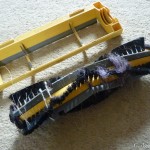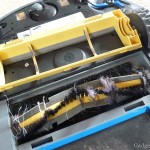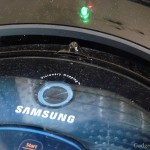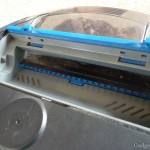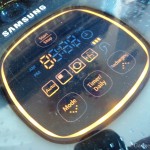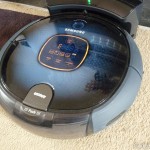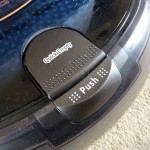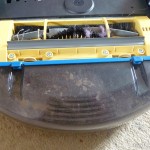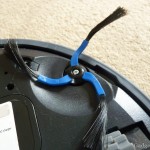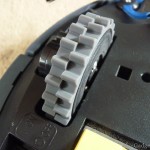Samsung SR8855 NaviBot Robot Vacuum Cleaner Review
I’ve never showed too much interest in robotic vacuum cleaners, the AIBO was a different story… after all, if you can get a pet which doesn’t leave hair all over the floor then a vacuum cleaner to keep it at bay is redundant.
But I got a delightful email saying there was a Samsung NaviBot available which I could gander at, and there was no way I’d turn down such an offer. The SR8855 is the latest robot vacuum cleaner from Samsung, placing an emphasis on dashing good looks (which Samsung seem fairly good at) and, of course, copying the Roomba as effectively as possible.
Samsung place a clear emphasis on the SR8855 NaviBot’s ability to pick up pesky pet hair, which is a shame because I possess only feather-shedding pets, and not the hair shedding variety that would give this vacuum a run for its money. Fortunately, I do have a 3-year-old daughter, who is probably far more effective than pets at making a mess.
The two-wheeled NaviBot trundles around the floor using two three-brushed rotating thingamees to attempt to gather up dust and dirt in the general vicinity of its main brush. The main brush, mounted centrally and somewhat towards the rear of the robot, is a standard rotating affair, you know the sort which inevitably get inseparably wrapped with hair and eventually conk-out. Fortunately the brush on the NaviBot seems to be quite resistent to conking out, even when wrapped in ridiculous amounts of hair… which is exactly the state in which it was delivered to me. Thanks, guys who reviewed this before me… thanks. Not.
After braving the dust/dirt-trap, which was also full of crud from the last people to test the NaviBot, and painstakingly separating the hair from the main brush which is, thankfully, completely removable, I was ready to put the NaviBot to the test.
The results were surprising. We’re not really very good at keeping abreast of the vacuuming in this house, or cleaning of any sort, with day-jobs, evening pursuits and the daughter there’s little time left for persistent cleaning. This means the floors are, generally, a little “bitty”, but I didn’t quite expect Samsung’s robotic Vacuum to pick up quite the ungodly amount of crud that it did.
Indeed, the little fella’ diligently trundled from room to room sucking it’s receptacle full of carpet lint, dust, dirt and even a fair helping of masonry dust, bits of mortar and other crap from our currently-being-renovated kitchen. The results were quite shocking, particular as the NaviBot didn’t leave particularly visibly clean floors, yet still managed to extract a positively ridiculous amount of dirt.
Emptying the NaviBot isn’t too tricky, the dirt compartment has a quick-release button and, like a cyclonic vacuum, no bag to worry about. Pop off the plastic container, flip up the top, empty the crud out with a round of violent shaking, pop out the filter and bash the dust off that… and then proceed to cough at the resulting cloud of dust rising from your bin. Voila! There’s also a quick-empty port, into which you can stick the end of your full-sized vacuum and, presumably, suck up the contents of the NaviBot without needing to get down and dirty with the dust receptacle.
The trouble is that the NaviBot seems to be exceptionally good at finding dust and dirt that can’t possibly exist, and seems to need emptying often. Clearly it’s doing its job, as the evidence is irrefutable (I’ll even include a disgusting picture below to prove it) but I can’t imagine how it’s managing to pick up all of this grime, whilst leaving so much behind.
Sadly, that’s the problem with the NaviBot. It’s not perfect. Whilst it picks up more dirt and dust than you can shake a pointy stick at, it tends to miss things and leave behind floors which are still visibly a bit dirty, if generally improved. Our rug, for example, is still covered with white bits of fluff, paper or crumbs, particularly around the edges where the NaviBot’s feeble rotating side brushes do almost nothing to remove them.
Clearly the NaviBot is supposed to be used in conjunction with a regular, perhaps weekly, cleaning schedule to provide all-round vacuuming coverage. It can’t lift the furniture, either, (yes you’re supposed to vacuum under your sofa!) so it’s really not going to replace manual vacuuming any time soon. What it does do, however, is impress guests, and keep floors looking just clean enough to convince people that you’ve actually vacuumed sometime in the last week.
If you’re truly spectacularly lazy, like me, and also can’t stand those little spots that the NaviBot just can’t seem to work its way into, you can use the IR (oh how I wish it was Bluetooth) remote to manually control the NaviBot both with the vacuum system on or off. Fire it up in manual mode and you can trundle it back and forth over the troublesome spot until it’s clean, and subsequently be proud of yourself for doing some “housework.” Hey, holding those buttons down is hard!
Alongside manual control are a plethora of options for automatic cleaning, including a scheduled or delayed start, “spot” cleaning, automatic cleaning and a button on the remote labelled “max” which doesn’t seem to do much.
When the battery starts running low after you’ve instructed the Samsung NaviBot to clean your floors 4 consecutive times, either for entertainment or because you actually want them reasonably clean and can’t be bothered to pick up the real vacuum, the NaviBot has a charging station into which it can navigate itself. It’s actually entertaining to watch the little blighter smugly negotiate its way into the charging station, a feat that I can’t seem to accomplish very effectively with manual control. Clearly it’s better at driving itself than me, that is until it’s supposed to hunt down and vacuum up dirt where my birds-eye view of the floor is far more effective than its pets-eye view of the ceiling.
To negotiate its way around obstacles the vacuum includes a variety of sensors, from the typical “I’ve just bumped into something” sensors on the front and sides, which seem to get triggered far too easily when it brushes up against a wall or sofa, to stair-safety cliff sensors, and the very obvious upward-pointing camera.
All I can say is: thank god Samsung didn’t make the NaviBot web-controllable, with the ability to look through its camera. Its perspective when there are people standing up in a room can’t be particularly appealing and it would similarly be petty useless for human control- we don’t normally walk from room to room staring at the ceiling. Samsung have placed the camera with some thought, however, because the NaviBot SR8855 will recognise the shape of your ceiling (the whole ceiling, it’s a wide-angle camera) and thus figure out the path it should use to traverse your room. Unfortunately it doesn’t seem to be able to see sofas, chairs, tables, people or, in fact, anything else with this camera, and its room navigation looks clumsy to say the least. Its negotiation of obstacles consists entirely of crashing into them, turning around, crashing into something else, turning around, clipping something slightly, turning around and, perhaps, finally sailing off in a new direction and inevitably missing a patch of floor that it could, if well navigated, have cleaned.
Overall, it’s a great little device. For the most part it clumsily trundles around the house picking up the easy bits of dirt, and moulting carpets (equivalent to pet hair, I suppose). It demonstrates what I might call brief flashes of intelligence, where it takes a direct path to an open doorway to reach the next room, or somehow stops short of an obstacle. And it doesn’t do too bad a job of cleaning up, picking up dirt and dust I didn’t know was there.
At what seems to be over £400, however, you’ve got to either be exceedingly wealthy, exceedingly geeky or exceedingly lazy to actually buy one of these. I’d love one, but I could get one hell of a powerful cyclonic vacuum for that price!

